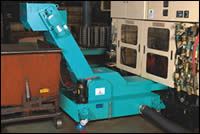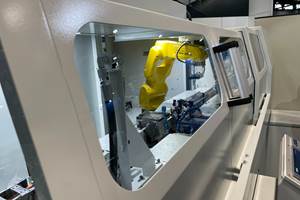Effective Filtration Adds Machining Hours
Sussek Machine says its expertise extends beyond what one might expect of a traditional job shop. Off-highway equipment OEMs comprise a large portion of the shop’s clientele, as the company machines steering arms, knuckles, shifter forks and other cast iron components.
Sussek Machine says its expertise extends beyond what one might expect of a traditional job shop. Off-highway equipment OEMs comprise a large portion of the shop’s clientele, as the company machines steering arms, knuckles, shifter forks and other cast iron components.
Throughout the company’s 100,000 square-foot facility located in Waterloo, Wisconsin, various machines, including robot-operated machining centers and automated parts handling equipment are employed to produce cast iron components machined from “castings to complete.” Established in 1960, the family-owned and operated business has in-house process and design engineering departments. It has also adopted Poka Yoke mistake proofing methods and a temperature-controlled metrology lab to achieve a less than 300 ppm quality rating. The company reports that this level of precision means that many parts go from Sussek directly to the assembly lines of its customers.
When it comes to cast iron, Sussek says that it can handle virtually any job. Nevertheless, Gregg Geier, production coordinator at Sussek, recalls one situation that had his company at a loss: how to eliminate machine downtime and the many hours of manual labor required to remove the substantial amount of cast iron chips and sludge produced.
“Not even today’s most productive CNC machines can make money when they’re down for cleaning,” says Mr. Geier. “For example, our Murata lathe has dual horizontal spindles; it is capable of removing a considerable amount of metal. For every 100 hours of machining time, we were spending 6 hours with the machine down, shoveling out more than a cubic yard of cast-iron sludge from the coolant tank.”
Finding a reliable means of filtering the particularly small residue called “fines” from coolant in cast iron machining operations has proven to be difficult. To alleviate the problem, the company installed the Cast Iron CDF Filter from Hennig, Inc. (Machesney Park, Illinois) about 6 months ago. So far, the company reports that the machine has not been down for coolant tank cleaning even once. Because Sussek has gained an additional 6 hours of machining time for every 100 hours, the system has paid for itself in just months.
The CDF platform embodies a self-cleaning, permanent-media design, which is said to reduce the amount of maintenance needed. Hennig realized that, with some modification, a CDF version for cast iron would be able to eliminate large volumes of cast-iron chips and fines from recirculating coolant without the need for disposable filter media or other complex systems.
First, dirty coolant from the Murata flows into the unit’s conveyor, which is positioned beneath the lathe’s coolant tank. Large chips and particles settle out and are removed by the system’s scraper belt, which continuously transports the material to the unit’s conveyor incline, where it then dumps the material into a chip hopper. Sussek operates the Murata three shifts per day, completely turning the braking surface and the hub end of cast-iron brake rotors, necessitating the removal by hopper of about one cubic yard of chips and sludge every shift.
According to the manufacturer, each CDF unit is designed to remove chips and relatively small particles from the coolant in high volumes. However, the particularly small particles found in cast iron are collected by a rotating magnetic drum unique to the CDF cast-iron unit. The magnetic drum catches cast-iron fines while at the same time indexing against a stainless steel blade that scrapes the fines off the drum. Once enough material has collected to form a heavy sludge, the sludge then drops onto the dry chip conveyor incline to be dragged along with the larger chips and fines and into the chip hopper.
Smaller particles that escape the magnetic field of the drum naturally migrate with the coolant flow toward the disc filter media, which uses a micronic-weave, stainless-steel mesh screen to intercept particles as small as 25 microns. As this filtration disc rotates past the 12 o’clock position, a continuous backwash spray of clean coolant blasts the particles that have been collected on the disc towards the rotating magnetic drum, where they magnetically adhere and are scraped off as sludge.
As a result, only clean coolant is allowed to eventually flow through the screens to the unit’s 75-gallon clean coolant reservoir, where it is then recirculated back to the lathe or used in the unit’s self-cleaning spray cycle.
Mr. Geier mentions that the simplicity of the system has been a plus. “We evaluated other units that were more complex, and yet none could completely prevent some sludge from eventually accumulating in the lathe’s coolant tank,” he says. “However, the stainless steel filter media discs that Hennig uses are tear and puncture resistant—an important factor because of the ‘bird’s nests’ and sharp, stringy chips produced in our turning operations.”
Also noteworthy is the system’s capability to minimize coolant replenishment costs. “Prior to using the machine, hot machining chips and sludge collected in the Murata’s coolant tank,” explains Mr. Geier. “The tank was slightly undersized, and it therefore gradually displaced the water-soluble coolant. This caused it to evaporate at an alarming rate, as less coolant got hotter through repeated use.”
“We needed a concentration of 5 percent coolant-to-water to optimize cutting conditions and prolong tooling life,” he continues. “However, water evaporation meant that the concentration of coolant was actually higher. This concentration caused foaming, creating unfavorable machining conditions. The current method is a stark contrast. By removing the chips and ‘heat’ from the process, we no longer have the added costs for frequent coolant replenishment or the potential for scrapped parts.”
Downstream, Mr. Geier recognizes the potential for other CDF unit applications at Sussek. “If ineffective cast-iron chip and sludge disposal is standing in the way of squeezing five, ten or just one part per hour more out of the machining process, then
this technology will remain a viable means by which we can stay competitive,” he says.
Related Content
Master Fluid Solutions Introduces Emulsion for Grinding and Cutting Operations
Trim E860 is said to be an ideal solution for heavy-duty and general machining.
Read MoreSTLE Opens Registration for 2024 Annual Meeting
The Society of Tribologists and Lubrication Engineers’ 2024 STLE Annual Meeting & Exhibition will take place May 19-23 at the Minneapolis Convention Center in Minneapolis, Minnesota.
Read MoreSTLE Hosts Co-Branded Tribology, Lubrication Events
The 2023 STLE Tribology Frontiers Conference and Tribology & Lubrication for E-Mobility Conference will provide attendees with two opportunities to share and learn the latest tribology and lubrication engineering science.
Read MoreIMTS 2022 Review: Attention to Automation Extends Beyond the Robot and the Machine
The advance toward increasingly automated machining can be seen in the ways tooling, workholding, gaging and integration all support unattended production. This is the area of innovation I found most compelling at the recent International Manufacturing Technology Show.
Read MoreRead Next
Obscure CNC Features That Can Help (or Hurt) You
You cannot begin to take advantage of an available feature if you do not know it exists. Conversely, you will not know how to avoid CNC features that may be detrimental to your process.
Read MoreThe Cut Scene: The Finer Details of Large-Format Machining
Small details and features can have an outsized impact on large parts, such as Barbco’s collapsible utility drill head.
Read More3 Mistakes That Cause CNC Programs to Fail
Despite enhancements to manufacturing technology, there are still issues today that can cause programs to fail. These failures can cause lost time, scrapped parts, damaged machines and even injured operators.
Read More















.png;maxWidth=300;quality=90)















